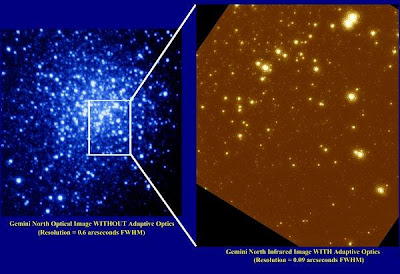
photo: Photo courtesy of Gemini Observatory, National Science Foundation, and the University of Hawai'i Adaptive Optics Group.The image on the left was taken without adaptive optics (AO), the image on the right was with AO. Notice that the starlight is much more concentrated with the AO System and produces significantly sharper images.An AO system was installed on Gemini North in early 1999.
Whenever starlight passes through our atmosphere, it's distorted by turbulence - similar to what we feel when traveling in an airplane. We've all seen the effects of this turbulence on stars, it's called twinkling. Because twinkling blurs images made through a telescope, scientists go to great lengths (and heights) to reduce its effects.
One of the reasons that the Hubble Space Telescope was put high above the earth's atmosphere was to escape its adverse effects. Since earth orbit is not an option for Gemini, a relatively new technology called Adaptive Optics will be used. Adaptive Optics simply takes a sample of starlight, determines how the atmosphere bent it, and then uses a deformable mirror to "straighten" the starlight out again. Sounds simple? Well, there's a bit more to it than that, here are a few more details...
Because stars are so far away, starlight passing through our atmosphere consists of parallel rays of light that are bent and diverted by air of different temperatures and therefore different densities. Of course our atmosphere is constantly changing and mixing together, so the effect is very random and quite dynamic.
When starlight enters a telescope like Gemini, if nothing is done, the distortions caused by the atmosphere are magnified and stars often look more like shimmering blobs than the pin-points of light they would be if viewed from space. However, before starlight passes into many of the instruments or cameras on Gemini, a representative column of starlight is diverted into what is called a "Wavefront Sensor."
The column of light entering the wavefront sensor is a representative sample of the light that is being collected across the entire main mirror of the telescope. In other words, any distortions that are visible to the wavefront sensor correspond directly to distortions somewhere in the atmosphere above the telescope. In order to use this information, the wavefront sensor separates the column of light into many areas or zones and samples each zone to determine how the light was altered by our atmosphere.
By taking samples many times per second, the information from the wavefront sensor is fed back to a "flexible" mirror that can be adjusted (like a funhouse mirror) to counteract for the distortions caused by the atmosphere. However, unlike a funhouse mirror, these adjustments are very small, and can't even be seen if you were to watch the mirror.
AO systems work best with longer wavelength light, which means that Gemini will see the most dramatic results with infrared observations. Using this system, it is expected that Gemini will produce the sharpest images yet of the infrared sky and dramatically improve many other types of observations as well.
Recently Gemini has found an exo-planet using this technology.
No comments:
Post a Comment